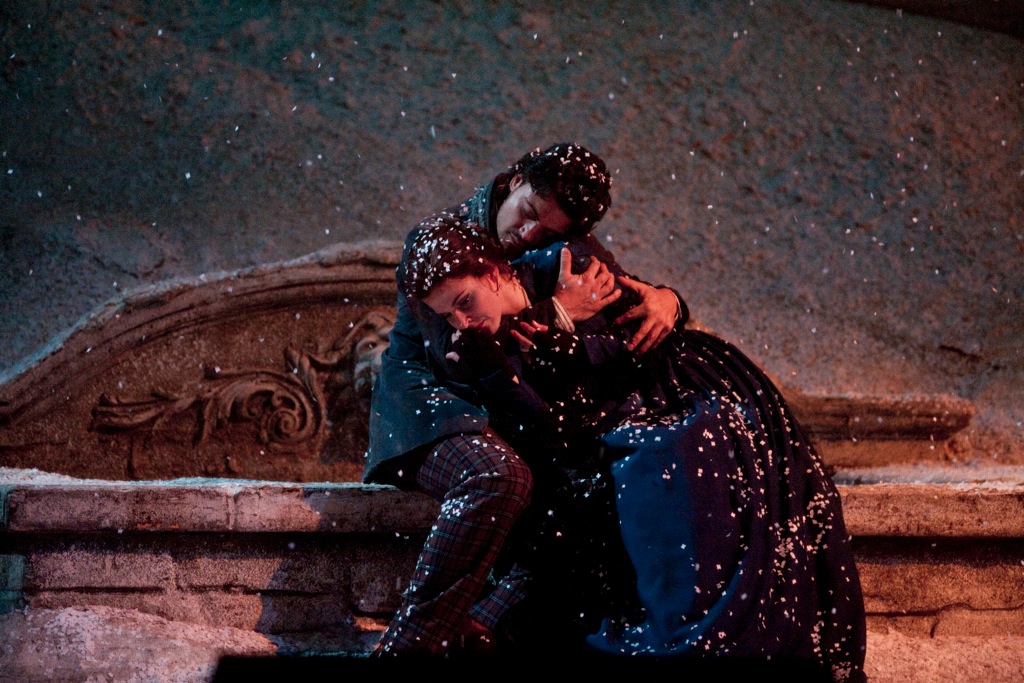With a strong cast, Met’s “Bohème” works its practical magic

Vittorio Grigolo and Maija Kovalevska in the Metropolitan Opera production of Puccini's "La Boheme." Photo:Marty Sohl
The Metropolitan Opera has not had a season without La Bohème, since 1997-98, which must give Franco Zeffirelli’s production a status in the opera world not unlike Agatha Christie’s Mousetrap in London theater. Inevitably, casts have had their ups and downs, but last year’s, headed by Anna Netrebko and Piotr Beczala, may well have been the finest the production’s lavish sets have yet accommodated.
Only two members of that cast—the excellent bass with a single name Shenyang (Colline) and the veteran Paul Plishka (Benoit and Alcindoro)—returned for the season premiere of Bohème on Saturday night, but the lineup stimulated interest by including a number of promising debutants, including the much touted 33-year-old Italian tenor Vittorio Grigolo.
Grigolo scored what was reportedly a huge success at Covent Garden in London last June in a new production of Massenet’s Manon originally meant for Rolando Villazón. A major profile in The New York Times over the weekend further fueled the high expectations, even noting that some have dubbed Grigolo the new Pavarotti. It bears remembering that Villazon, now in vocal straits, was once heralded as the new Domingo.
A more sensible subject for comment might be the heartening fact that after a long barren period Italy is again producing tenors worth hearing, Giuseppe Filianoti, also currently at the Met, being another case in point. Blessed with good looks and an abundance of charisma, Grigolo made a vibrant Rodolfo in his debut with the company, taking his place comfortably among the three other young Bohemians who share a flat in Paris’s Latin Quarter.
One cannot say with precision exactly why the Covent Garden audience went into ecstasy over him, but it is worth bearing in mind that Manon is not an Italian opera but a French one. Hearing Grigolo on Saturday night, one could spot qualities that suggest he might excel in the French repertoire. He does offer the pleasure, of course, of hearing an Italian sing in his own language. But the voice is not particularly large and it has a flexibility that allows for nuanced control of dynamics, a quality welcome in singing of any sort but especially apt for the French language.
Not that Grigolo made any particular effort on Saturday to call attention to the sheer artistry of his singing. Projecting an ardent image was clearly a more central concern. But the voice sometimes sounded a bit thin and is certainly lacking in liquid tone and sheer luster. The public may yet embrace it, just as they have Andrea Bocelli’s. Time will tell.
Rodolfo’s Bohemian colleague Marcello also benefited from a strong portrayal from a Met debutant, Italian baritone Fabio Capitanucci. From his opening lines about drowning a pharaoh in the Red Sea (on canvas, that is—Marcello is a painter), Capitanucci sang with an engaging, well-formed sound that projected well in the large house. He reacted sympathetically to Mimì’s plight in Act 3 and he comfortably held his own in the duet with Grigolo at the start of Act 4.
Still another notable debut came from soprano Takesha Meshé Kizart, as Musetta. Kizart served notice of having significant Verdi credentials with a Forza Leonora at Caramoor in 2008, and you could hear them in the rich tones of her somewhat darkish voice as she assayed Musetta’s waltz. She was also a lively presence on stage but deserves to have her pay docked for excessively self-congratulatory gestures during curtain calls.
The cast also included Latvian soprano Maija Kovalevska, by now a familiar figure as Mimì, and rightly so. Hers is a brightly focused, youthful sounding soprano, but she displayed the vocal reserves for the role’s more expansive utterances and brought expressive power to the Act 3 aria Donde lieta usci. Edward Parks from the Met’s young artist program was an acceptable Schaunard.
The conductor Roberto Rizzi Brignoli, also in a Met debut, shaped phrases attentively but his tendency to set sluggish tempos meant that dynamism was in short supply. On stage the traffic patterns flowed smoothly under David Kneuss’s direction.
La Bohème will be performed 15 more times through Feb. 25, 2011. 212-362-6000; metopera.org
Posted Oct 18, 2010 at 4:59 am by PRESIDENT MERV
Kizart’s Musetta was embarrassingly bad. She shrieked her way through Musetta’s Waltz and was off pitch several times.
Posted Nov 01, 2010 at 9:19 am by Mr. D
Well, I was present on the 28th and had a very different impression of Ms. Kizart. While her voice is significantly darker than a traditional Musetta, I thought she gave an excellent performance that was dynamic both dramatically and vocally. I was thoroughly impressed. I am very much in agreement with Mr. Loomis’s concerns about Grigolo, though, and found that Brignoli exhibited similar sluggishness during the performance I saw. There were also numerous moments where Brignoli seemed challenged to maintain cohesion between the orchestra and the singers.